Chevrolet Pattern 12 Engine Page Two
The Chevy Lubrication System
The Chevy Dipper Lubrication System
Is one of those things that seems like it should not work, but it does. The system is based on dippers on the end of each connecting rod which scoop oil up out of troughs in the oil pan at low speed and when starting. Once the engine picks up RPM the oil which be splashed from the troughs is replaced by streams of oil coming from the oil nozzle in each trough. The stream of oil is aimed so that the scoop is passing collects it at high speed.
High performance books of the 50s provide much interesting information. That the stock system of lubrication would meet the lubrication needs of most hot rodding power improvements. Changes that would take the engine to more than twice the horsepower produced by CMP engines from 84 HP to well over 150 HP.
The adjustment of the trough. and aiming of the nozzle of course is critical to the life of the engine. There are several special tools which though simple ensure that the system works and works well.
-
Fig 44 shows the tool for checking the height of the dipper scoops to insure clearance
- Fig 45 shows checking the trough. for clearance over the nozzle
- Fig 46 shows checking the trough. for depth related to the scoop.
- Fig 47 Shows the most interesting part of the system setup using water to check the actual aiming of the oil nozzle
- Below and below left show the actual testing of the system Interesting
what you see with eyes vs. what you see when you take a flash photo
and high speed shutter setting. What looks to the eye like a narrow
tight stream coming out the nozzle is in fact a stream made of droplets
that is more than twice as wide as wide as the eye sees.
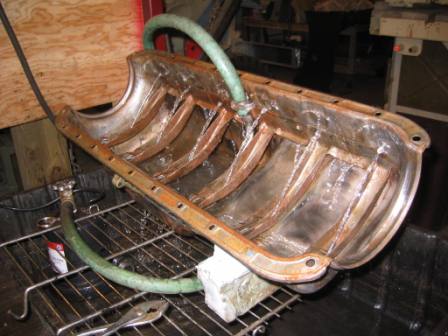
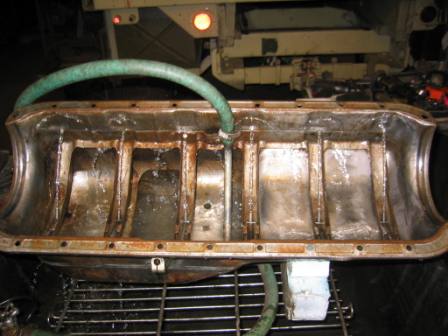
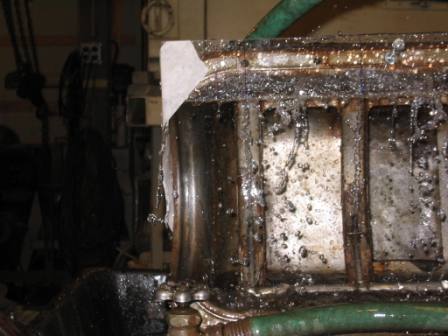
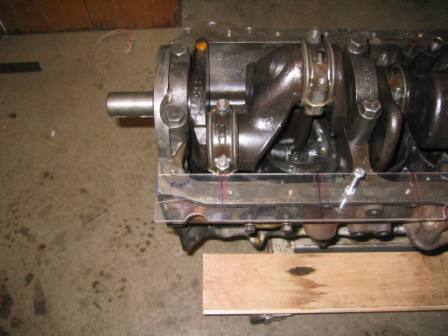
Even took some video of the test. Interesting that with the streams coming out straight from the nozzles they all hit up at the top edge of the oil pan at about 2 psi pressure reading at the pump. Gives you a new appreciation of the oil pump and “splash” oil system, the extended sump on the CMPs is a big improvement on the regular oil pan. Video of test
The pump I was using for the test was putting out better than 10 gallons a minute during this test.
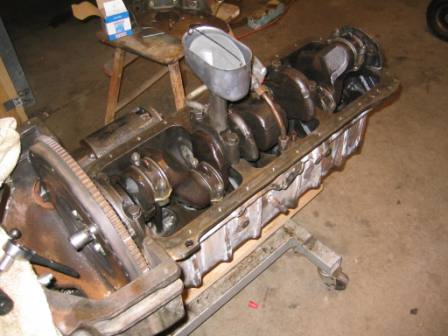
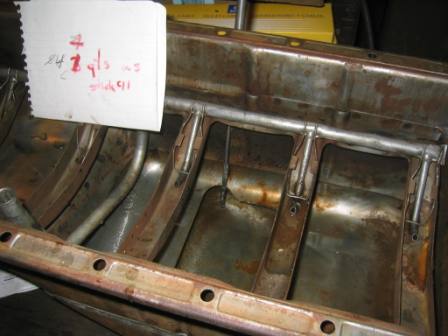
Oil Depth and Dip Stick
The engine is a 1952 Chevy 216 which had the shallow oil pan. The issue is that when mating the CMP deep pan with the engine need to make sure that the dip stick reads correctly. This would seem simple but what I discovered is that the 41 dipstick is shorter than 42 or 45 by an inch and 4 inches longer than the 52 shallow pan dipstick.
The CMP manual calls for 5 quart oil change if crankcase and filter are drained and 6 if the oil filter is replace. Of course manual is talking imperial quarts and I'm putting in US quarts.
| Imperial Quart | = | US Quarts |
|
2.5
|
3
|
|
|
3.33
|
4
|
|
|
4.16
|
5
|
|
|
5
|
6
|
|
|
6
|
7.2
|
|
To determine the correct level I tried filling the oil pan one quart (US using a graduated cylinder) at a time noting the depth as each quart was added. The first thing that becomes clear is that you can have nearly 3 quarts US of oil in the lower sump when the dip stick tip is just showing oil. That the full mark takes 6 quarts US which would agree with the manual.
Several things are interesting to note:
- That the deep sum oil pans most of the oil is carried in the lower pan.
- Oil troughs each hold 2 ounces for 12 ounces in total.
- With my other trucks if engines oil is topped off to the full mark the oil leakage seams to increase and that the rate of leakage drops once the engine is reading 1quart low.
- That a half inch oil in the pan equals roughly a quart US of oil
- The bottoms of all Chevy Dip Sticks are the same measuring from the bottom the Add oil line being an 1 1/4" and the Full line being 1 3/4"
Conclusion that the wrong dip stick can result in a quart to much or
to little oil in the engine.